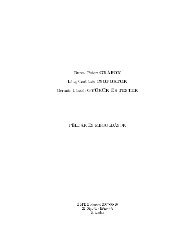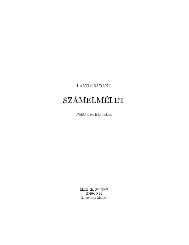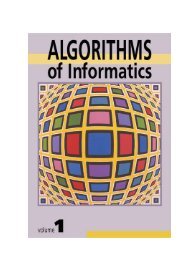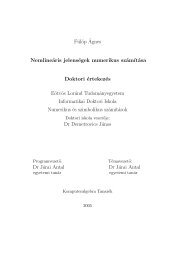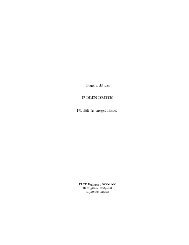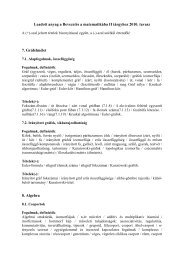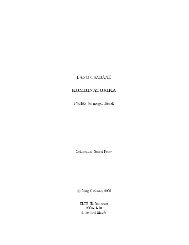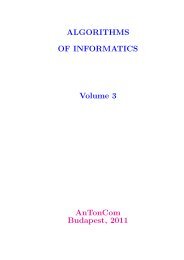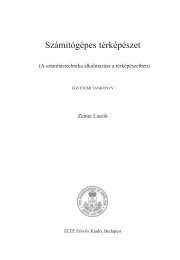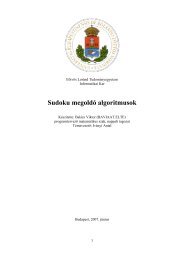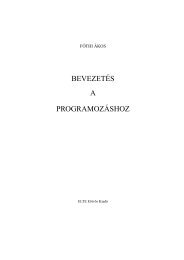On Erd˝os-Gallai and Havel-Hakimi algorithms
On Erd˝os-Gallai and Havel-Hakimi algorithms
On Erd˝os-Gallai and Havel-Hakimi algorithms
You also want an ePaper? Increase the reach of your titles
YUMPU automatically turns print PDFs into web optimized ePapers that Google loves.
<strong>On</strong> Erdős-<strong>Gallai</strong> <strong>and</strong> <strong>Havel</strong>-<strong>Hakimi</strong> <strong>algorithms</strong> 15<br />
p < n), then the assertion is the consequence of <strong>Havel</strong>-<strong>Hakimi</strong> <strong>and</strong> Erdős-<br />
<strong>Gallai</strong> <strong>algorithms</strong>, since the zero elements do not help in the pairing of the<br />
positive elements, but from the other side they have no own requirement. <br />
The <strong>algorithms</strong> based on this corollary are called <strong>Havel</strong>-<strong>Hakimi</strong>-Zerofree<br />
(HHZ), resp. Erdős-<strong>Gallai</strong>-Zerofree (EGZ).<br />
5.2 Shifting <strong>Havel</strong>-<strong>Hakimi</strong> algorithm<br />
The natural algorithmic equivalent of the original <strong>Havel</strong>-<strong>Hakimi</strong> theorem is<br />
called <strong>Havel</strong>-<strong>Hakimi</strong> Sorting (HHSo), since it requires the sorting of the<br />
reduced input sequence in every round.<br />
But it is possible to design such implementation, in which the reduction of<br />
the degrees is executed saving the monotonity of the sequence. Then we get<br />
<strong>Havel</strong>-<strong>Hakimi</strong>-Shifting (HHSh) algorithm.<br />
For he pseudocode of this <strong>algorithms</strong> see in [37].<br />
5.3 Parity checking <strong>Havel</strong>-<strong>Hakimi</strong> algorithm<br />
It is an interesting idea the join the application of the conditions of Erdős-<br />
<strong>Gallai</strong> <strong>and</strong> <strong>Havel</strong>-<strong>Hakimi</strong> theorems in such a manner, that we start with the<br />
parity checking of the input sequence, <strong>and</strong> only then use the recursive <strong>Havel</strong>-<br />
<strong>Hakimi</strong> method.<br />
For the pseudocode of the algorithm <strong>Havel</strong>-<strong>Hakimi</strong>-Parity (HHP) see in<br />
[37].<br />
5.4 Shortened Erdős-<strong>Gallai</strong> algorithm (EGSh)<br />
In the case of a regular sequence the maximal value of Hi is n(n−1), therefore<br />
the inequality (2) certainly holds for i = n, therefore it is unnecessary to check.<br />
Even more useful observation is contained in the following assertion due to<br />
Tripathi <strong>and</strong> Vijai.<br />
Lemma 6 (Tripathi, Vijay [84]) If n ≥ 1, then an n-regular sequence b =<br />
(b1 . . . , bn) is n-graphical if <strong>and</strong> only if<br />
<strong>and</strong><br />
Hi ≤ min(Hi, i(i − 1))<br />
Hn even (13)<br />
n<br />
min(i, bk) (i = 1, 2, . . . , r), (14)<br />
k=l+1



